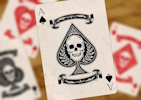Prosperia - A Tabletop RPG Prototype for My Coworkers
- Tabletop RPGs, Game Design, Anecdotes

I'm a big fan of role-playing video games, especially Japanese-style ones, but there's a big restriction these games have: players have limited abilities to create their own stories in them due to programming restrictions. When I discovered tabletop role-playing games, having this restriction lifted in exchange for imagination and a bit of randomness made me realize the magic and potential of this interactive method of storytelling.
However, tabletop RPGs are usually plagued with hundreds, if not thousands, of pages of rules, causing a big barrier of entry, players arguing over rules, long phases of tactical calculations and probability tests, and players attempting to abuse rules in their favor to make a ridiculously-powerful character instead of being immersed into the game world.
Despite this issue, I wanted to find a way to share with less-geeky people the joy of role-playing, but couldn't find one that was both simple and not completely absurd. Only one solution then: try to make my own!
Design vision
My primary goal was to achieve a game that could be described as the following: a tabletop role-playing game that emphasizes interactive storytelling over enforcing rules.
Ouch. That's quite the ambitious goal.
I decided to put on myself several design restrictions to achieve this:
- The rules for players should fit on two pages at most.
- The rules should easily be adaptable to any setting.
- The rules should allow a good customization of characters that enables almost any archetype.
- Rules about character actions should only handle cases where players might argue with a potential outcome.
- The rules should be designed to minimize metagaming.
- The rules should trust the judgment of the game master to manage complex situations.
Influential experience
Critical IF
I had been a fan of gamebooks since their popularity peak in the 1990s, but the finest ones in my opinion are the Critical IF gamebooks by Dave Morris, originally released under the Virtual Reality series. These books are: Heart of Ice, Down Among the Dead Men, Necklace of Skulls, and Once Upon a Time in Arabia (originally released as Twist of Fate).
A few elements set these gamebooks apart:
- There is no randomness.
- Generating a player character only requires picking 4 skills from a set of 12.
- A password system acts as boolean flags which enables or blocks specific branching paths in the story when acquired.
- In addition to the above, players only need to track their life points, money and up to 8 possessions.
For those interested in the design of these books, Dave Morris has published the original Virtual Reality gamebook guidelines on the Fabled Lands blog.
Radical Dreamers
Here's an odd one: Radical Dreamers is a fantasy visual novel exclusively released through the Satellaview, a satellite-connected modem for the Japanese version of the Super Nintendo Entertainment System. Oh, and it's the sequel to Chrono Trigger, arguably one of the best video games of all time, and later remade as Chrono Cross, a train wreck of a game that is somehow less immersive over the original despite the massive increase in production values.
The reason why I'm mentioning Radical Dreamers here, besides the fact that I highly recommend playing it over its remake, is because the game, while being fully played through reading paragraphs and selecting from a list of predetermined actions, actually tracks health and relationship strength with one of your teammates, but only shows this information to the player as walls of text instead of raw numbers. This makes the adventure a whole lot immersive... at least until the game starts repeating the same descriptions. Similarly, sometimes picking an action is time-sensitive, although no timer appear on the screen. Once time expires, the choices disappear and the game moves on, making dangerous encounters a lot more tense.
Shadowrun
Shadowrun 3rd Edition is the first tabletop RPG I've ever played, and I still enjoy it a lot despite its flaws. The setting in particular is interesting: a mix of cyberpunk and fantasy where player characters play criminal mercenaries for megacorporations running the world.
From a pure rule set perspective, these elements are particularly noteworthy here:
- Tests are based on throwing 6-sided dices. Whenever a 6 is rolled, it is re-rolled and added to the new roll value until a different value appears.
- The number of dices rolled are equal to the character's skill value, plus any number of dices from a limited dice pool per turn for specific actions.
- Skills can be specialized, at the expense of the main skill.
- By default, the difficulty of a test is based on reaching a target value on each dice, with better outcomes per success.
- For some tests against two characters, instead of having a target number when dice rolling, the winner is the character achieving the highest number possible on any dice.
- There are two damage gauges, one physical and the other for stun. Both gauges have a maximum of 10 points, and cause unconsciousness at or below 0. Whenever the physical gauge is no longer positive, it continuously drops until it reaches -10, in which case the character dies.
- Damage, damage prevention and damage-based penalties on tests are based on the triangle number sequence.
I also played Shadowrun 4th Edition, but I'm not a fan of the changes overall. For instance, the way tests were handled made games less satisfying, as players would no longer roll ridiculous amounts of dices to resolve them. Also, 4th Edition introduced wireless networks, which basically allows characters to control attack drones and hack stuff remotely while staying outside of any kind of danger, and while doing so has its drawbacks, it made games less exciting.
Papers, Please
Papers, Please is a video game with a rather bold and innovative method of storytelling: most of the major decisions in the game are limited to stamping "APPROVED" or "DENIED" on passports. Despite this apparent limitation, the player has a major influence on global political issues based on who he lets go through, with an incentive to break the law due to his poor living conditions. It's even possible to outright cause a revolution.
While this game is not an RPG, I really enjoyed the idea of a single man doing simple things stuck in a repressive political machine full of propaganda, and yet had the power to change everything, for both himself and countless number of people, by taking advantage of his position.
Aventures
Turns out, I was not the first to attempt to make role-playing games appeal to a mass audience. The long-running French series Aventures also attempted to do so, although from a viewer perspective instead of a player.
Here's a few highlights of their game design:
- All random tests are based on the result of a single 100-sided dice, with 1 being the best outcome and 100 the worst. A test is successful if the result is smaller or equal to the target.
- Outcomes from 1 to 5 are considered critical successes, while outcomes from 96 to 100 are critical failures, mimicking Dungeons & Dragons's probabilities. The result of the critical is at the game master's discretion.
- Characters only have 3 attributes: build, social and mind. Each of them can go up to 100, and are the default targets for generic tests for that player.
- Skills are simply modifiers to the base targets for specific actions, with the exception of magical abilities which may have additional restrictions to execute.
Note that the team behind Aventures has been working on a tabletop version for the general public, but as of this writing it has yet to be published.
Iterating from the best
Setting
The easiest setting to learn is the one people already knows best - their own. However, that might not be the most interesting fictional setting to explore.
To counter this problem, I decided to go with a modern world with modern technology, but with different geography and geopolitical issues for a flavorful setting.
In particular, I decided to go with the player characters starting in a communist dictatorship similar to Papers, Please's, with its borders initially cut from the rest of the world in order to build the rest of the world during gameplay. That way, if the players wanted a more fantasy setting for example, the game master could just introduce a country of fantastic creatures and artifacts granting magical powers later on.
Percentage-based tests
In order to keep things easy to understand, I decided to follow the Aventures model and keep all tests based on a single 100-sided dice roll, so that each test target would match the percentage of success.
Critical outcomes
I really enjoy the uncommon epicness of critical successes and the chaos of critical failures. However, I felt that having the classic 5% probability for each was too high, as I've frequently experienced strings of devastating bad luck with such probabilities. For reference, with those rates, the probability of two critical failures separated by at most 2 non-critical failures is 14.2625%.
Therefore, I tried using a 3% probability for each type of critical instead of 5%. This would lower the probability of two critical failures separated by at most 2 non-critical failures to 11.470719%.
Character creation
Again following the Aventures model, I decided to go with the 3 base attributes model, which I called Body, Intelligence and Social. Players could assign 150 points between them, with a maximum of 100 for each.
For skills, I decided to get inspired by the Critical IF model and tried to come up with a list of 12 skills, 4 for each base attribute, that would be equally useful. Players could allocate 60 points between them, and their value would be added to the base attribute before modifiers for tests. They were:
- Athletics (Body)
- Culture (Social)
- Driving (Intelligence)
- Empathy (Social)
- Fighting (Body)
- Persuasion (Social)
- Roguery (Intelligence)
- Sciences (Intelligence)
- Senses (Body)
- Shooting (Body)
- Streetwise (Social)
- Survival (Intelligence)
In addition, I got inspired by Shadowrun and allowed specialization of skills, and made each skill point worth 2 if invested in a specialization instead of the main skill. I gave players arbitrary specializations to allow them to make their dream character, but only allowed specializations that I judged would only be useful in 1/3 of the situations that character would encounter over the base skill.
As for the reasons I picked 150 attributes points and 60 skill points, it was because I was considering an average non-player character to have 50 in each attribute and 0 in each skill, which would make the players a bit better than the average Joe, with sufficient customization.
Character growth
I wasn't a big fan of models I was already familiar with for character growth. However, I still thought it was important to give players a reward that represented the improved skills of their characters.
My solution was two-fold. First, I decided to reward all players at the end of each mission regardless of its result with 10 skill points assigned by the game master, based on what they actually attempted during the mission. Second, if the mission was successful, I would also grant them 5 additional skill points and 5 attribute points, both of which they could distribute as they wished. Once again, skill points could be doubled if invested in a specialization.
Tests
As much as I like throwing a bunch of dice at once, I considered accessibility to be a priority. As such, I followed the Aventures model again so that a test probability given as a percentage and the test result would directly match.
The success of a test was determined by whether the following formula was true:
result of 100-sided dice roll ≤ base attribute + skill + specialization + context modifier
To clarify, context modifiers is a value decided by the game master to control the difficulty of a test.
This simplistic formula however is not enough to handle tests involving multiple players at the same time. For cooperating players, I decided to go with the statistic of the most skilled player with an arbitrary context modifier bonus for the purpose of the prototype. For opposing players, I figured doing separate tests that could nullify each other would be good enough for the rare occasions it would happen.
Damage
For the sake of the prototype, I did not focus on creating rules for damage, and instead decided to use my own judgment to determine the health of characters. I did like the Shadowrun model for it however, so the only concrete thing I told the players was that they had to be careful of both physical and stun damage.
For the same reason, I decided to avoid working on statistics for items or equipment for the time being.
Money
In order to prevent everyone from tracking money, I decided from a more ballsy approach and give the player characters unlimited budget. In order to achieve that while controlling the resources the player characters had to a reasonable level, I came up with the idea that their operations would be funded by the government.
This design decision pretty much forced the profession of the player characters to be secret agents, something that I knew would end up being similar to Shadowrun's mercenaries, and allow the same types of missions if not more, so that was perfect fit.
Hidden tests
One problem I've seen in many tabletop RPGs is players metagaming, or in other words acting differently after learning of a game state their character should not have knowledge about. For instance, if a character would try to hide in a bush, and its player would have a bad hiding test result, the player would find the first valid excuse to stop hiding. Another instance would be when asking the player for a perception test, which by itself encourages the player to be cautious regardless of the outcome.
To counter this, I decided to make the result of all tests that relates to hidden information checked by the game master and their result secret, hoping the players would trust the game master to not cheat. That way, just like Radical Dreamers, the story would be emphasized instead of the game mechanics. I even told the players I would fake test checks so they couldn't guess when I was really doing a test to eliminate that source of information.
Secret messages
At some point in the game, I introduced evidence that characters could become brainwashed. I decided to push the idea that it would affect gameplay as well by exchanging secret messages to players at specific points during the game written on paper. To achieve this, the players were told the following rules:
- You must follow what is instructed on the paper.
- If the instructions prompts for a response, you must reply secretly as well.
- You cannot disclose the contents of the secret message, but your character may communicate any information from it that does not violate one of its directives.
- Failure to follow these rules would lead to a severe in-game penalty, the extent of which would be at the discretion of the game master.
What the players didn't know is that I had no intention of brainwashing their characters in the first place, only cast suspicion between them for greater immersion.
Instead, I used this technique to grant specific players private information to nurture their character's unique traits, including setting up side quests and red herrings.
Playtest implementation
Invitation
To make a playtest, you need players, and one of the main reasons I designed this prototype in the first place is because I wanted to have a fun activity to share with my coworkers during lunch breaks. Fortunately, the social committee at the time was very open to this idea as they were looking for team-building activities in the office.
You have to keep in mind what kind of people there were in my workplace though. I was in a development studio working on financial software, and most of the on-site team were either programmers or quality assurance analysts. So basically, it was a bunch of nerds that never played a tabletop RPG before. It was a perfect audience for the prototype, although it also means that the playtest results needs to consider that it is not representative of the normal population.
For a little while, I worked with Tomas Valettini, one of the members of the social committee, on a proper name to the event, finding a schedule for it that would not disrupt normal work operations, and to create an invitation. I called my prototype Secret State during development, but that didn't sound good enough, so instead we went with the name of the fictional country as the name of the game: Prosperia. Of particular note, Tomas worked on the final version of the Prosperia flag seen in the post image above, based on a copyright-free picture.
Here is the text contents of the email I sent to the entire studio along with the Prosperia flag picture:
Hello all!!
This is to invite you to participate in our interactive game that will take place during lunch time. As your host, I will guide you through a journey (twice a week) that will decide the fate of the futuristic land: Prosperia!!
This activity is based on the concept of Dungeons & Dragons, however, the rules will be simple and easy to learn so everyone can participate. You can also join in as a spectator if you want.
If you are interested, please fill out [...]
If you have any questions, feel free to contact me (or Tomas Valettini from the social committee).
In an alternate world, the great nation of Prosperia, governed by the Honorable Great Leader, has entered a new era of modernity after starting to open its borders for the first time in 200 years. Respectable citizens are seeing these changes with hopeful eyes, but not all is well. Centuries-old terrorist organizations are planning to use this opportunity to overturn the government, while contact with the outside world is starting to corrupt the most unlikely of people to the Absolute Evil.
As a new recruit in Prosperia's secret service, you have the responsibility of maintaining the country's political stability and help respectable citizens to achieve the Collective Dream. Will you bring Prosperia to a new glorious age, or bring it to ruins? Will you follow the will of the Honorable Great Leader, or will you fall to the Absolute Evil? Prosperia's destiny is in your hands.
Mission design
Before giving a proper mission, I first gave the players a tutorial that would put them right in the heat of action. They had to assist to their first briefing meeting as secret agents in a seemingly-abandoned building... except the meeting was a set up! The building really was abandoned, quickly catched fire, firemen remained passive once they arrived at the scene, and a sniper awaited them outside as they tried to climb down the exterior walls. Fortunately, it was actually the player character's final exam to be admitted as secret agents, and the sniper was their new boss and missed on purpose! All well's that ends well!
The first mission proper was for the player characters to meet a cranky terrorist, but not to stop him. Instead, they would use him by helping commit a specific crime: assassinate a cow during a live broadcast! A damn cheese factory destroyed the terrorist's farm and life after all, so it was time for revenge against the company's mascot! Things slowly started going sour as players discovered that the cheese company was sponsored by a rival country which sent fake cows along with the real one to brainwash listeners of the broadcast!
The second mission was to investigate the cause and effect of the brainwashing, which would lead the player characters to a school where brainwashed people would meet up and be trained unconsciously for a coup d'état, and the man pulling the strings would turn up to be a dead immigrant from the rival country being controlled by a parasite beyond the grave.
I was planning for the following missions to be visiting the rival country and find information about the parasites, and turning out that the country was much more advanced technologically but ravaged by aliens, and that player characters would have to team up with the local resistance to eventually stop the aliens. I was even considering a potential cataclysm that would reduce the world to a techno-fantasy state depending of how the players decided to stop the aliens, Unfortunately, that never materialized.
Results
Gunfight specialization
I've had a few players during character creation attempt to allow gunfight as a specialization of the Shooting skill. According to my judgment, in a modern setting, that's too close to the 1/3 usefulness limit rule that I enforced... at least outside of the Olympic Games.
But then, how do you divide gunfight skills? One of the players, as a revision, proposed short-ranged firearms as a specialization. If you haven't realized, that's basically any type of gun that's not a sniper rifle. Still no good.
In the end, no player characters had shooting specializations due to this confusion. I believe that's because players pretty much expected gun-related skills to bleed over each other.
Drones
To my biggest surprise, once players got to the armory for the first time to get their spy equipment, every single one of them requested a drone of some sort. I'm assuming the first player, once making that request, gave the idea to everyone else, although I can't be sure of this.
However, as I mentioned earlier, because of my experience with Shadowrun, I didn't want to put drones in player characters' hands due to them no longer needing to take any big risk while operating them. The fact that they had unlimited budget also meant that they could have unlimited drones as well. For these reasons, drones had to be banned from the game. And yet, everyone was asking for one.
Struggling for a quick solution, I came up with the excuse that drones was still an emerging technology in the game world, mostly reserved for military purposes, an explanation that players reluctantly accepted.
I think the real mistake was to give unlimited budget to the players in the first place and assuming in-game supervision would be enough to prevent abuse.
Unclear dice roll results
Every time I asked a player to perform a test, I would often hear the same following questions over and over:
- "How do I calculate the target value again?"
- "Which result is good again, one bigger than the target, or one smaller?"
Yes, I was surrounded by programmers and QA analysts working on a financial application, and they were struggling with a single formula that only involved 1st grade math operations, for months.
Clearly, my assumptions about the success of the Aventures model were completely wrong. But why is that?
First, I believe the reason why players got confused with the direction of the inequality was because they expected larger numbers to be better, not worse. I was basically fighting against human nature, which is a big no-no in game design theory.
Second, I think the reason why they couldn't remember which variables to add together was because the formula was too complex to be intuitive. Even when I had already added up the skill to the specialization in each player's character sheet, it was still too many variables to remember.
Skill bias
Even though I tried to make each skill be equally important, in practice some skills were much more widely used than I expected, especially Senses and Persuasion. In addition, in the case of Senses, despite a lot of related tests being hidden, there were still a lot of them the players were aware about.
I'm not sure if it was because of the type of missions, or just the fact that secret agents had to deal with more of these types of tests than I expected. I believe it's a mix of both.
Critical rolls
To make sure that the reduction of critical probabilities worked as intended, I tracked all instances of 4s, 5s, 96s and 97s being generated to see where it would make a difference. Ironically, those results never happened despite their high probability over hundreds of tests, so actual effects of this decision could not be assessed.
That said, for some reason, I felt that critical outcomes were not common enough this time around compared to my previous experience. Obviously it wasn't an effect of my decision, but it made me question whether my previous assessment was incorrect. Unfortunately I didn't collect the data necessary for this analysis.
Nonsensical training
As soon as I introduced the concept of player characters gaining skill points for using those skills in-game, players suddenly started using every opportunity to train their characters in the skill they wanted to develop whenever nothing important was going on, such as reading books or practicing a skill at home.
The issue is that these behaviors brought absolutely nothing to the global story, and instead encouraged players to break character and delay the game.
An unexpected rival appears
Throughout the entire experience, none of the players questioned the results of the hidden tests, which I was grateful for. However, it led to some interesting results.
At some point during their adventure, players encountered a small mob boss that tried to kill one of their informants, kidnapped her... and left her alone in a hotel room... guarded by a single player character... without confiscating her powered-on cellphone... after telling her boss that they kidnapped her from said cellphone. Yeah, not their wisest move. Needless to say, she escaped.
Later, players figured out that she was going to meet an important accomplice at a restaurant. Throughout the entire event, all player characters attempting to track her had consecutive critical failures to do so, a fact that players did not realize until it was too late due to the hidden test results. So instead, they tracked a similar-looking woman that was having an affair with a completely-unrelated politician, and concluded he was the contact. Of course, as they tried intervening, the enemies escaped, and hilarity with the politician ensued.
Because of this, a throwaway character suddenly became a memorable escape artist and a major enemy, and I doubt this would have happened without the help of hidden tests based on my original reasoning for this design decision. It was to a point were I had planned for that character to eventually become the dictator's wife if the story would have continued further.
However, at some point during the restaurant event described above, player characters stormed the place and forced non-player characters at gunpoint to stand next to each other so they could identify everyone easily. Afterwards, one of the players specified that he was going to exclusively look at the small mob boss.
I suddenly had a conundrum to deal with. One one hand, the player character had just failed a hidden test about noticing her disappearance a little earlier. On the other hand, the same player character was now actively looking for her among a neatly aligned series of people.
I took the decision of overturning the hidden test, as I could not come up with any plausible explanation as to why the player character would still think she was still present despite not doing another critical failure. Thinking of it after the fact, I think I would have reacted the same way if the test information had been public in the first place, although I still have some doubts, which is why I'm mentioning it here.
Suspicions between players
In the end, the secret messages technique caused the following:
- The player character guarding the small mob boss getting knocked out and becoming the prime suspect by the other players for her escape because they assumed he had done so against his will.
- A private party invitation that turned out to be a side quest to save important non-player characters from being poisoned by a cheese cake.
- One player character accidentally buying stocks in the main antagonist's front organization, and their boss figuring it out and communicating the information to the others.
Interestingly, even when I gave pointless information through secret messages, it always somehow ended up indirectly becoming plot points that players cared about, partially thanks to my style of game mastering.
Therefore, I'd say secret messages were a great tool, although I believe it should be one restricted to experienced game masters only to ensure it doesn't delay the story or cause players to needlessly fight against each other.
Overall fun factor
In the end, the players had tons of fun with their first tabletop RPG experience. In particular, the game balance felt just right with player characters that didn't seem weak or overpowered. Players especially enjoyed the missions design, my acting skills for the NPCs and the incredible stories they were living together. One player even took notes of every single detail to make sure he didn't miss anything, which is a level of dedication and immersion I have never seen in my role-playing experience beforehand.
The only real issue was that we had one problem player that I let go crazy for too long, but that wasn't related to the prototype itself, but rather due to being my first time encountering this situation.
Overall, I would say that the prototype was an amazing success as it met the original goal, but could still be improved in major areas. If it weren't for negative changes in our work environment that were outside of our control during the playtest, I believe we would have continued playing a lot longer than we ended up doing.
Ideas for next revision
Based on the above results, I was able to prove that the prototype was a good foundation. If I ever iterate on it for a future role-playing session, here are some areas I believe I should be focusing on:
- The basic setting is great and should stay as-is.
- Larger numbers should always represent better.
- Individual statistics should probably be redesigned due to balancing issues between them and due to specialization confusion. This should be done with a similar level of character creation balance.
- Test success formula needs to be redesigned for intuitiveness. Attributes and skills may need to be merged to achieve this.
- Test success rules should better handle actions involving multiple characters.
- More research should be done to determine optimal critical probabilities.
- It's OK to embrace multiple standard 6-sided dice as most people don't appear to really care about exact probabilities as long as they have good points of reference.
- Real damage rules should be implemented, but be kept simple.
- Always let players assign character growth bonuses as they wish outside of the game.
- A limited budget should be enforced with a currency value that players are already familiar with.
- It might be good to explicitly include strict rules about hidden information.
- Drones should be allowed, but a major drawback should be implemented in addition to cost, such as traceability of the operator.
...Whew, that was quite the debriefing! 😅
Related content I wrote

Deconstructing Social Dynamics and Relationships Through Neurodiversity
- Psychology, Anecdotes
From a very young age, people learn how to interact with other people, and this learning experience continues through puberty and adulthood. How are people similar from each other? How are they different from each other? What is and is not socially acceptable? How does context influence what should…

Creating the Perfect Tabletop Role-Playing Game Scenario
- Tabletop RPGs, Game Design
After having many years of experience running successful tabletop role-playing games with and without relying on prewritten scenarios, I was able to craft a successful formula to generate original, fun and engaging scenarios for the kind of rules-light games with an emphasis on actual role-play that…

How to Play Liar's Deck (From Liar's Bar) - Full Rules and Variants
- Video Games, Game Design
The following are the rules of the Liar's Deck bluffing card game and its official variants, first introduced in the Liar's Bar video game. These rules are based on its in-game tutorials, observations I made from gameplay sessions, and comments from the game's developers. While there may be a few…

The Future of the Video Game Randomizer List
- Video Games, Programming, Anecdotes
It's hard to believe that it's been almost 8 years since I first posted on the ROMhacking.net forums a list of video game randomizers that I found online, and that it would evolve into the massive project it has become today, with almost 900 entries currently being listed. It's always a strange…

My Personal Video Game Completion List
- Anecdotes, Video Games
I thought it would be fun to track the long list of video game that I have beaten and/or completed for reference, so I've done just that! There may be a few mistakes here and there due to secret features unknown to me, or due to misremembering details of my past gaming experiences, but I believe the…